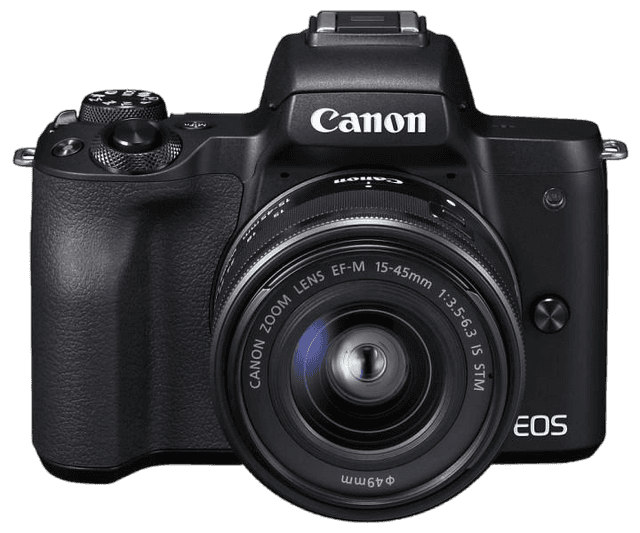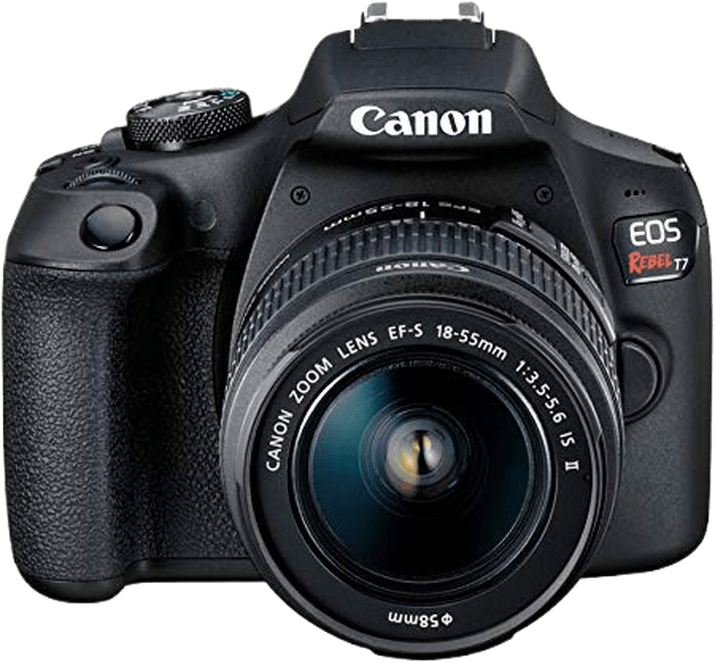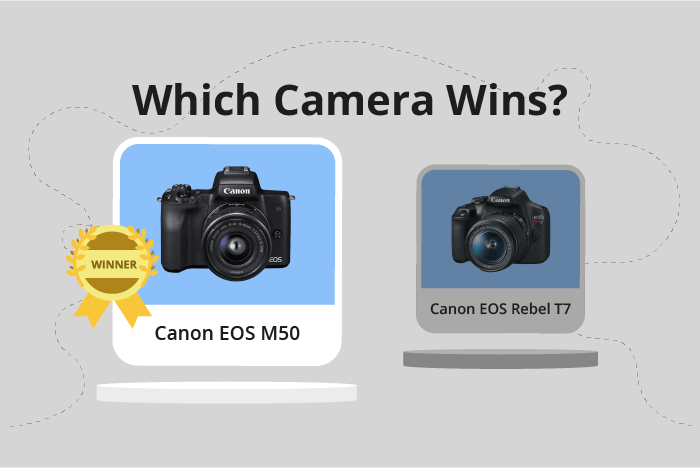Canon EOS M50 vs EOS Rebel T7 / 2000D Comparison
Canon EOS M50

Canon EOS Rebel T7 / 2000D

The Canon EOS M50 outperforms the Canon EOS Rebel T7 / 2000D with a score of 59/100 compared to 50/100. Both cameras were announced on February 26, 2018, and share similar specifications, such as their release year and announcement date.
The EOS M50 is a mirrorless camera, making it lighter and more compact than the EOS Rebel T7, which is a DSLR. The M50 weighs 390g and has dimensions of 116 x 88 x 59mm, while the Rebel T7 weighs 660g and measures 129 x 101 x 78mm. This makes the M50 a more portable and convenient option for on-the-go photography.
On the other hand, the EOS Rebel T7 comes at a lower launch price of $550, compared to the EOS M50’s launch price of $779. This price difference may make the Rebel T7 more attractive to budget-conscious consumers.
Taking into account the specifications, the Canon EOS M50 is the better camera due to its lighter weight and compact size. However, the Canon EOS Rebel T7 may still be a good option for those looking for a more affordable DSLR.
Canon EOS M50 vs EOS Rebel T7 / 2000D Overview and Optics
The Canon EOS M50 wins in the optics comparison with a score of 59/100, while the Canon EOS Rebel T7 / 2000D scores slightly lower at 56/100. Both cameras share common specifications, such as 24 (M50) and 24.1 (T7 / 2000D) megapixels, CMOS sensor type, APS-C sensor size, and the absence of image stabilization.
The EOS M50 outperforms the Rebel T7 / 2000D in several aspects. It has a faster shooting speed of 10 compared to the T7 / 2000D’s 3, which allows for better action and sports photography. Additionally, the M50 has a more advanced processor, the Digic 8, which contributes to better image processing and overall performance. The M50 also features the Canon EF-M lens mount, providing access to a growing range of lenses specifically designed for mirrorless cameras.
On the other hand, the Rebel T7 / 2000D has a higher DXOMARK sensor score of 71, as opposed to the M50’s 58. This implies that the T7 / 2000D has the potential for better image quality in certain situations. Furthermore, the T7 / 2000D utilizes the Canon EF-S lens mount, which gives users a wider selection of lenses, including those designed for DSLRs.
In terms of optics, the Canon EOS M50 stands out due to its faster shooting speed, advanced processor, and compatibility with mirrorless-specific lenses. However, the Rebel T7 / 2000D should not be overlooked, as it offers a higher sensor score and a broader lens selection. Ultimately, the choice between the two cameras depends on individual preferences and specific photography needs.
Canon EOS M50 vs EOS Rebel T7 / 2000D Video Performance
The Canon EOS M50 emerges as the clear winner in video capabilities with a score of 91 out of 100, while the Canon EOS Rebel T7 / 2000D trails significantly with a score of 43 out of 100. Both cameras share some common video specifications, such as having a built-in microphone and manual exposure mode.
The EOS M50 outperforms the Rebel T7 / 2000D in several aspects. Firstly, it has a maximum video resolution of 4K (3840 x 2160), compared to the Full HD (1920 x 1080) resolution offered by the Rebel T7 / 2000D. This means the EOS M50 can capture higher quality, more detailed videos. Secondly, the EOS M50 has a higher maximum video frame rate of 120fps, while the Rebel T7 / 2000D is limited to 30fps. This allows the EOS M50 to produce smoother slow-motion videos. Lastly, the EOS M50 has built-in time-lapse functionality, which the Rebel T7 / 2000D lacks.
The Rebel T7 / 2000D does not have any specific advantages in video capabilities compared to the EOS M50. Its lower score reflects its limitations in resolution, frame rate, and the absence of time-lapse functionality.
Considering these factors, it is evident that the Canon EOS M50 is superior in video performance. Its higher resolution, faster frame rate, and built-in time-lapse functionality make it a more versatile and capable camera for videography. Meanwhile, the Canon EOS Rebel T7 / 2000D falls short in these areas, making it a less desirable option for users focused on video recording.
Canon EOS M50 vs EOS Rebel T7 / 2000D Features and Benefits
The Canon EOS M50 outperforms the Canon EOS Rebel T7 / 2000D with a feature score of 70/100 compared to the latter’s 41/100. Both cameras share some common specifications, such as a 3-inch screen size, the absence of GPS, and the presence of WiFi connectivity.
The Canon EOS M50 excels in several areas, including a higher screen resolution of 1,040,000 dots compared to the 920,000 dots of the Canon EOS Rebel T7 / 2000D. Additionally, the M50 has a touchscreen, allowing for easier navigation and control of camera settings. The M50 also has Bluetooth connectivity, providing added convenience for transferring files and remote control of the camera.
On the other hand, the Canon EOS Rebel T7 / 2000D has a flip screen, which is a useful feature for capturing images from different angles. However, it lacks the touchscreen and Bluetooth capabilities of the M50, which limits its overall user experience and convenience.
In comparing the Canon EOS M50 and the Canon EOS Rebel T7 / 2000D, it is clear that the M50 offers a superior set of features, making it the better choice for photographers seeking a versatile and user-friendly camera. The Rebel T7 / 2000D may still be a viable option for those who prioritize the flip screen feature, but its lower feature score and lack of additional connectivity options make it a less appealing choice overall.
Canon EOS M50 vs EOS Rebel T7 / 2000D Storage and Battery
The Canon EOS Rebel T7 / 2000D outperforms the Canon EOS M50 in storage and battery with a score of 27/100 compared to the M50’s 13/100. Both cameras have one memory card slot and accept SD, SDHC, and SDXC cards. However, the M50 is UHS-I compatible, providing faster read and write speeds.
The Rebel T7 / 2000D offers a significantly longer battery life of 500 shots, while the M50 only manages 235 shots. This makes the Rebel T7 / 2000D more suitable for extended shooting sessions without needing to change batteries. Both cameras use different battery types, with the Rebel T7 / 2000D using the LP-E10 and the M50 using the LP-E12.
Neither camera offers USB charging, which could be a drawback for users who prefer the convenience of charging via USB. Despite this shared limitation, the Rebel T7 / 2000D’s longer battery life makes it the better choice in terms of storage and battery capabilities. The M50’s UHS-I compatibility is an advantage, but its shorter battery life may limit its usefulness for some users.
Alternatives to the Canon EOS M50 and EOS Rebel T7 / 2000D
Are you still undecided about which camera is right for you? Have a look at these popular comparisons that feature the Canon EOS M50 or the Canon EOS Rebel T7 / 2000D:

